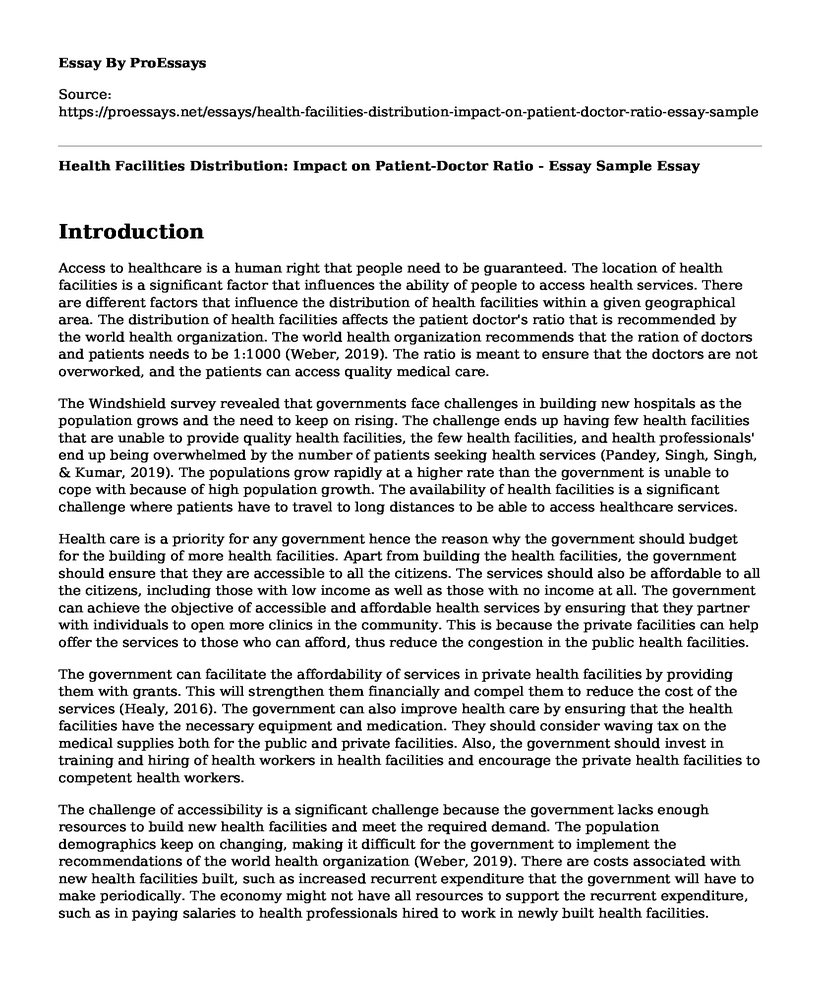Introduction
Access to healthcare is a human right that people need to be guaranteed. The location of health facilities is a significant factor that influences the ability of people to access health services. There are different factors that influence the distribution of health facilities within a given geographical area. The distribution of health facilities affects the patient doctor's ratio that is recommended by the world health organization. The world health organization recommends that the ration of doctors and patients needs to be 1:1000 (Weber, 2019). The ratio is meant to ensure that the doctors are not overworked, and the patients can access quality medical care.
The Windshield survey revealed that governments face challenges in building new hospitals as the population grows and the need to keep on rising. The challenge ends up having few health facilities that are unable to provide quality health facilities, the few health facilities, and health professionals' end up being overwhelmed by the number of patients seeking health services (Pandey, Singh, Singh, & Kumar, 2019). The populations grow rapidly at a higher rate than the government is unable to cope with because of high population growth. The availability of health facilities is a significant challenge where patients have to travel to long distances to be able to access healthcare services.
Health care is a priority for any government hence the reason why the government should budget for the building of more health facilities. Apart from building the health facilities, the government should ensure that they are accessible to all the citizens. The services should also be affordable to all the citizens, including those with low income as well as those with no income at all. The government can achieve the objective of accessible and affordable health services by ensuring that they partner with individuals to open more clinics in the community. This is because the private facilities can help offer the services to those who can afford, thus reduce the congestion in the public health facilities.
The government can facilitate the affordability of services in private health facilities by providing them with grants. This will strengthen them financially and compel them to reduce the cost of the services (Healy, 2016). The government can also improve health care by ensuring that the health facilities have the necessary equipment and medication. They should consider waving tax on the medical supplies both for the public and private facilities. Also, the government should invest in training and hiring of health workers in health facilities and encourage the private health facilities to competent health workers.
The challenge of accessibility is a significant challenge because the government lacks enough resources to build new health facilities and meet the required demand. The population demographics keep on changing, making it difficult for the government to implement the recommendations of the world health organization (Weber, 2019). There are costs associated with new health facilities built, such as increased recurrent expenditure that the government will have to make periodically. The economy might not have all resources to support the recurrent expenditure, such as in paying salaries to health professionals hired to work in newly built health facilities.
Conclusion
In conclusion, the accessibility of healthcare services is a significant challenge affecting people where patients are unable to access healthcare when in need. Governments need to come up with strategies to ensure people can access healthcare when in need. The Windshield Survey recommended various strategies that can be applied, including differentiating health facilities to offer specific services and reduce overwork among health practitioners.
References
Pandey, A., Singh, A., Singh, S., & Kumar, A. (2019). Patient-doctor ratio across nine super-specialty clinics in government hospital: a cross-sectional study. International Journal of Community Medicine and Public Health, 6(10), 4421.
Weber, D. (2019). How Many Patients Can a Primary Care Physician Treat?. Physicianleaders.org. Retrieved 19 April 2020, from https://www.physicianleaders.org/news/how-many-patients-can-primary-care-physician-treat.
Healy, J. (2016). Improving health care safety and quality: reluctant regulators. Routledge.
Cite this page
Health Facilities Distribution: Impact on Patient-Doctor Ratio - Essay Sample. (2023, May 23). Retrieved from https://proessays.net/essays/health-facilities-distribution-impact-on-patient-doctor-ratio-essay-sample
If you are the original author of this essay and no longer wish to have it published on the ProEssays website, please click below to request its removal:
- Advocating for Social Justice
- Research Paper on Dementia Disease State
- Weight, Diet and Body Image Essay
- Essay Sample on HIV and AIDS in the US
- Essay on Poor Planning of Community Health Assessment: Devastating Impact
- Paper Example on Pain Mgt: ANA, Joint Comm. Codes Provide Optimal Care
- Essay Example on Evidence-Based Practice: Enhancing Healthcare Quality and Patient Outcomes







